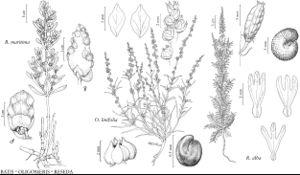Oligomeris linifolia
Contr. Gray Herb. 53: 13. 1918.
Plants usually annual, rarely perennial, 8–40 cm. Leaves: blade linear to oblanceolate, 0.8–5 × 0.05–0.2 cm, sometimes with hyaline basal teeth 0.2–0.4 mm, apex obtuse or acute, surfaces glabrous or scabrid. Inflorescences 2–12 (–25) cm; bracts persistent, linear to lanceolate, 1–1.5 mm. Flowers: sepals lanceolate to deltate, 0.7–1.5 (–2) mm; petals whitish, ovate, slightly shorter than sepals, 0.7–1 (–1.7) mm, usually distinct, sometimes barely connate basally; filaments 1.5 (–2) mm, barely connate basally; anthers 0.3–0.5 mm. Capsules sessile or subsessile, compressed-subglobose, 1.7–3 × 2–3.4 mm, apically 4-toothed, teeth acute, 0.5–0.7 mm. Seeds black or brown, 0.5–0.7 mm. 2n = 30.
Phenology: Flowering (Jan-)Feb–Jul(-Dec).
Habitat: Pastures, desert washes, sand dunes, creosote scrub, mesquite thickets, volcanic soil, sometimes in brackish or alkaline soils
Elevation: -60-1200(-1400) m
Distribution

Ariz., Calif., Nev., N.Mex., Tex., Utah, n Mexico (Baja California), n Mexico (Baja California Sur), n Mexico (Chihuahua), n Mexico (Coahuila), n Mexico (Durango), n Mexico (Nuevo León), n Mexico (Sonora), n Mexico (Zacatecas), sw, c Asia, n Africa, n Atlantic Islands
Discussion
The native status of Oligomeris linifolia in North America has long been controversial; its presence represents the most remarkable disjunction in the family. Recent molecular research (S. Martín-Bravo et al. 2009) strongly suggests that it is native here.
Oligomeris linifolia has been reported to be toxic to cattle. Occurrence of this species in Utah is based on the following collection: “southern Utah,” 1877, E. Palmer 47 (US, WIS). “Cambess” has appeared in literature as a common name for O. linifolia, apparently resulting from confusion with an abbreviation of the author Cambessèdes. “Lineleaf whitepuff” has also appeared as a common name for this species; the epithet linifolia should be translated as “flax-leaved.”
SELECTED REFERENCE Martín-Bravo, S. et al. 2009. Is Oligomeris (Resedaceae) indigenous to Noth America: Molecular evidence for a natural colonization from the Old World. Amer. J. Bot. 96: 507–518.
Selected References
None.
